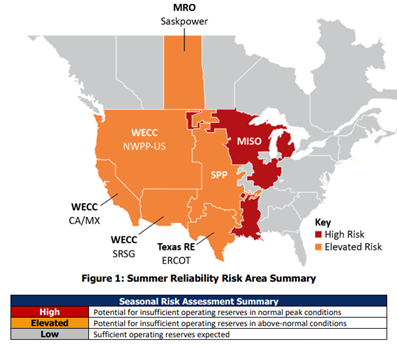Insights
better business decisions
Posted 3 years ago | 3 minute read

US at high risk of power emergencies this summer, says NERC
A chunk of the US, from California to Texas to the Midwest, is at risk of blackouts and unreliable power supply this summer as extreme heat and drought impact the electric grid, the North American Electric Reliability Corporation (NERC) has said.
In its annual assessment of grid conditions, published on May 18, NERC, warned that the grid serving much of the Midwest is at “high risk” for energy emergencies this summer. Meanwhile, grids that bring power to the West and Texas could also see serious problems.
Elevated or high risk of energy shortfalls this summer due to predicted above normal temperatures and drought conditions over the western half of the United States and Canada. These above-average seasonal temperatures contribute to high peak demands as well as potential increases in forced outages for generation and some bulk power system equipment.

Source: NERC
While NERC’s risk scenario analysis shows adequate resources and energy for much of North America, the Western Interconnection, Texas, Southwest Power Pool (SPP), and Saskatchewan are at “elevated risk” of energy emergencies during extreme conditions. Midcontinent ISO (MISO) is in the “high risk” category, facing capacity shortfalls in its north and central areas during both normal and extreme conditions due to generator retirements and increased demand.
While California and other Western states should have enough power to meet most of their demands, the report finds, extreme drought and heat conditions could create some emergencies. Extended drought conditions present varied threats to capacity and energy across the country. In the Western Interconnection, the widespread drought and below-normal snowpack has the potential to lead to lower-than-average output from hydro generators, threatening the availability of electricity for transfers throughout the Interconnection.
In Texas, wide-area heat events coupled with drought can lead to higher-than-expected peak electricity demand and tighter reserve conditions. Meanwhile, as drought conditions continue over the Missouri River Basin, output from thermal generators that use the Missouri River for cooling in SPP may be affected in summer months. Low water levels in the river can impact generators that use once-through cooling and lead to reduced output capacity.
GridBeyond SVP North America Wayne Muncaster said:
“Given temperatures are already rising, this summer is shaping up to be challenging for the power systems. Grid operators in affected areas will need all available tools to keep the system in balance this summer.
“As the climate continues to warm, we’ll keep loading the dice with greater possibilities of extreme weather and system planners need to realise this is not a fleeting issue that will go away. It’s crucial that we take action now to preserve our power systems over the long-term as we face a growing population, and rising summer temperatures. The solutions are out there.
“The focus so far is generally on the supply-side of the market, while this is important, more action is needed to encourage investment in demand response, energy storage and energy efficiency as a cost-effective means to manage pressure on the supply-side.”

Webinar: The Power of Participation | How to optimize your energy strategy to cut costs, increase resilience and secure sustainable growth
For energy-intensive businesses, such as those in the metal sector, there has never been a better time to review their energy strategies to ensure maximal resilience, cost optimization, and increased sustainability.
Learn more






